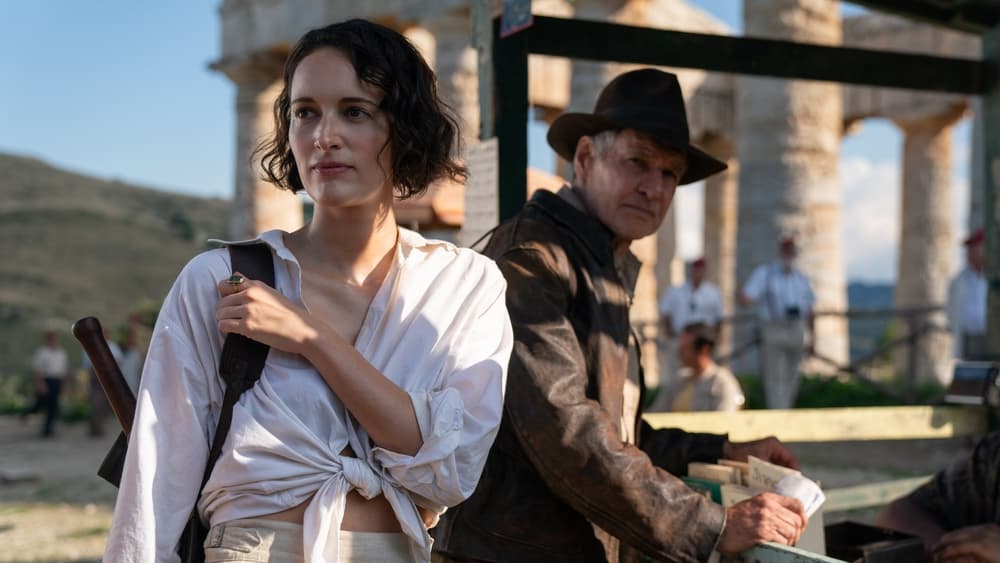“Indiana Jones and the Dial of Destiny” is a pastiche of a pastiche. While the original “Indiana Jones” films were throwbacks to the 30s and 40s adventure serials Steven Spielberg and George Lucas grew up with, the only point of reference for the latest installment in this series is the four movies that came before. Many of the pieces that make up your typical great Indiana Jones film are here. Beloved characters return, like Sallah (John Rhys-Davies) and Marion (Karen Allen). John Williams composes another rousing, adventurous score. But there’s one key element missing: Steven Spielberg.
It’s apparent from the opening sequence that something is off about the film visually. The dimly lit, digital effects-laden German Alps look both unconvincing and ugly in a way that takes all tension out of the situation. The tactile nature of the original film’s stunts is what creates a sense of reality in unrealistic set pieces and also adds tension because what you are seeing appears to really be happening. In this new film (and “Kingdom of the Crystal Skull to a lesser extent), the fake, rubbery aesthetic makes the action sequences look like video game levels that you don’t even get to play.
Apart from how bad the film looks, James Mangold’s direction is surprisingly incompetent. Mangold does try to stray too far from what Spielberg normally does in these movies, but by doing so only shows how one-of-a-kind Spielberg is. Mangold’s skill for visual comedy doesn’t come close, timing being his biggest issue either telling the joke too slow to surprise the audience or too fast for the joke to register, and he often relies on scripted dialogue for humor which seems like it could work with the hilarious Phoebe Waller-Bridge in the cast, but doesn’t because the written jokes aren’t funny. Mangold’s action direction is also surprisingly weak, often creating wildly incoherent set pieces with no sense of spatial geography and erratic staging.
The biggest issue with Mangold’s direction is how little he trusts the audience. Every other shot of something mysterious or important that the characters find is accompanied by an unnecessary line of dialogue explaining what you’re looking at. For a film that is all about exploration and figuring things out, it really doesn’t want you to work too hard to connect the dots yourself. This is a problem that has run rampant in Hollywood blockbusters for years now, but it feels especially wrong in an “Indiana Jones” film when Spielberg’s direction gave you all the information you needed visually — to the point that a Steven Soderbergh re-cut of “Raiders of the Lost Ark” removes all sound and you can still completely understand what is happening.
Viewers who thought “Kingdom of the Crystal Skull”’s nuclear bomb fridge escape or interdimensional beings were instances of this franchise jumping the shark haven’t seen anything yet. “Dial of Destiny,” more interested in science and the universe than the original three films’ obsession with religion and the supernatural, somehow creates something less believable in the climax of its story. The fifth installment of this franchise introduces time travel as a scientific reality within the “Indiana Jones” universe, and for no apparent reason at that. The reveal doesn’t impact the characters in any meaningful way. It does look like Indiana Jones (Harrison Ford) is going to resign himself to death after being shot, having finally seen all he could ever dream of seeing, and the film looks like it’s going to reach a poignant conclusion on aging and existing in a world that doesn’t need you — in a similar way to how “No Time To Die” handled the death of James Bond. But, at the last moment, “Dial of Destiny” decides that it doesn’t want that kind of ending. Instead, it cops out, and the real ending for the character is a moment of reconciliation with Marion, which doesn’t work because Marion hasn’t been in the movie until then. The entire arc that the ending would be a satisfying resolution to happens off-screen.
“Indiana Jones and the Dial of Destiny” is terrible, far worse than anyone who disliked “Kingdom of the Crystal Skull” could ever imagine. At least when the previous installment was making dumb narrative decisions, Spielberg’s direction could be counted on to produce a thrilling action sequence or an arresting image — say what you will about the fridge scene, the image of Indiana Jones staring up at the mushroom cloud is a gorgeous, powerful shot. As what will likely be a finale for this character (the third sendoff he has gotten), it isn’t satisfying in the slightest.

